Rabbit breeding principle
Rabbit breeding is gaining popularity among farmers again. Rabbits are one of the most prolific pets. One female per year can produce up to 30 rabbits, which is about 70 kg of meat. Reproduction - rabbits are one of the most important aspects that every farmer should know the intricacies of.
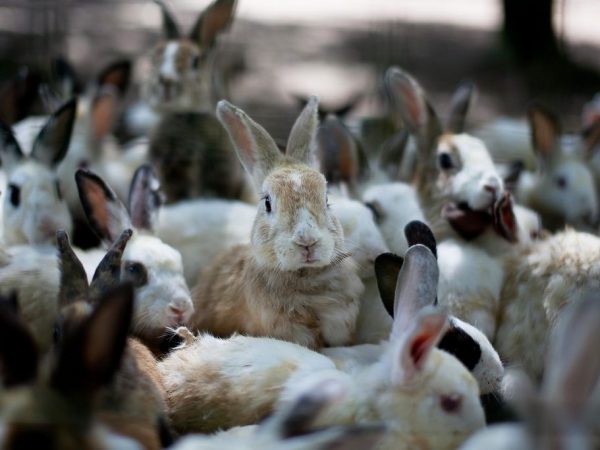
Rabbit breeding process
Classification and some features
In total, about 200 different breeds are known in the world. All of them are divided into several types:
- meat;
- meat and skin;
- skinny;
- decorative.
The latter variety is used for aesthetic purposes only. Before you start breeding rabbits at home, you need to decide on your goals and choose the appropriate breed. It is advisable to buy sexually mature individuals.
The basis of the diet of rabbits is plant food. Under natural conditions, these animals form colonies. Burrows are used as housing.
Rabbits are ready for breeding as early as 4 months. The rabbit bears offspring for 29-31 days. The offspring is born completely unadapted to environmental conditions. The rabbits are completely naked, blind and deaf, therefore, in the first weeks they need especially careful care. Upon reaching the age of seven days, babies begin to become covered with fluff, and on the tenth day their eyes open.
It is very important for novice rabbit breeders to study all aspects related to fertilization, reproduction and development of the newly born offspring. It is on how comfortable conditions the owner can create for the pets that their fertility will depend.
One of the most important points is normal living conditions. The cage should be purchased or designed by hand before purchasing rabbits. You should take care of a separate housing in advance: after fertilization, the rabbit will need to be transplanted into a separate cage.
Criteria for selecting rabbits
Reproduction of rabbits at home begins with the selection of healthy individuals capable of reproducing healthy offspring. Depending on what production type the breed was selected, you should pay attention to some features. Rules and criteria for choosing rabbits for a tribe:
- length of the body and its addition;
- body weight, the animal should not be too well-fed or skinny;
- quality and color of the coat.
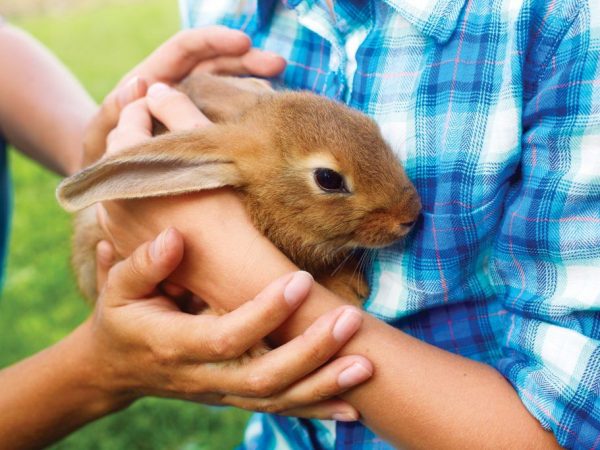
Rabbit selection
A healthy individual should have a strong physique, clean eyes and shiny hair. Should never buy for breeding individuals whose appearance is in doubt. If the rabbit has hips, sagging belly or back, the head is irregular, the coat is in a deplorable state, it means that the individual is not able to give healthy offspring and most likely itself needs treatment.
Rabbit shelter
A comfortable cage is a top priority for everyone who decides to breed rabbits at home. The content of rabbits can be closed and open. Animals kept in an open way can withstand cold temperatures down to -20 ° C and are more resilient.
Rabbits have a negative attitude towards high humidity and drafts. Rabbit houses should be large enough, light and dry. The older generation and the young should not be kept in the same area. The longer the rabbits stay with their mother, the better their immunity will be and the more weight they can gain.
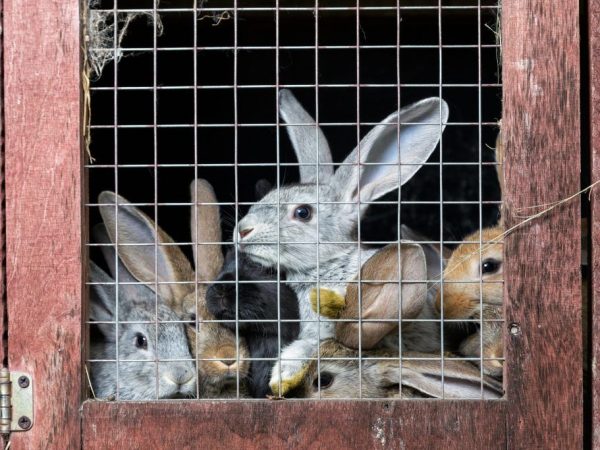
Rabbit shelter
It will be cheaper to make a construction for a rabbit residence on your own. The back wall of the cage should be solid, without gaps. In one of the side walls, a manhole is made to enter the walking area. The interior of the container is divided into functional parts for feeding, drinking and sleeping nests. The front wall is made of mesh, the flooring is made of wooden planks, and closer to the end, the mesh is attached: this is where the rabbits will defecate.
Considerable attention should be paid to the drinking system. Many people make the mistake of pouring water into a small container and not adding it during the day. For normal development and maintenance of good immunity, rabbits need a sufficient amount of water. One adult per day accounts for about 0.5 liters of liquid. If the diet of animals is dominated by succulent grass, the amount of fluid consumed is reduced.
Breeding features
Reproduction of rabbits begins with the selection of breeding individuals and culling when they reach sexual maturity. Crossbreeding between close relatives is not encouraged, especially novice farmers should not be inbreeding. Breeding individuals are selected, observing the following rules:
- take representatives of the first and second litters;
- the breeding rabbit is chosen in the first days after birth, the largest rabbit will be the ideal option;
- great attention is paid to weight, moreover, the animal should not be obese, but at the same time it needs to have a normally developed muscular system;
- the hairline can say a lot about the health of the pet, therefore, choose only those rabbits whose hair is shimmering and does not stick out in tufts.
Females are selected mainly already experienced, who have shown themselves to be on the good side.
Culling of males and females is carried out after several cases. First-born females often cannot give a good offspring right away and are not always able to provide appropriate care for their offspring, however, they quickly learn and do 2-3 times without outside help. Males are discarded if they are unable to fertilize the female in every third case. If the female did not fertilize after the control mating, then she is also discarded.
A high fertility rate in females is a good milk production. The male must be highly sexually active. If the animal is lazy and inactive, it is discarded. For a small farm, 2 inseminating rabbits will be enough. It is necessary to frequently cleanse the blood in the rabbit herd by purchasing new breeding animals.
When rabbits are brought together
Any experienced farmer knows how rabbits breed. This is the basis for a successful farm. The weight of the animals at the time of mating must be at least 3 kg. Rabbits reach sexual maturity at 4 months, but if the optimal weight has not been reached, it is better to wait some more time, otherwise pregnancy will adversely affect the health of the female and offspring. The age when the rabbits are ready for mating will depend on the breed characteristics and how quickly the young were transplanted from their mother:
- the smaller the representatives of the genus, the earlier they can produce offspring;
- the longer rabbits receive breast milk, the more resilient they become and the faster they gain weight.
It is very important to mate within the allotted time, because overexposure of animals leads to obesity, which negatively affects the quality of fertilization or leads to the death of most of the offspring. Sexual heat in males begins at 6-8 months, it is at this age that they are ready for mating. There are certain rules by which the examination and identification of individuals ready for fertilization is carried out.
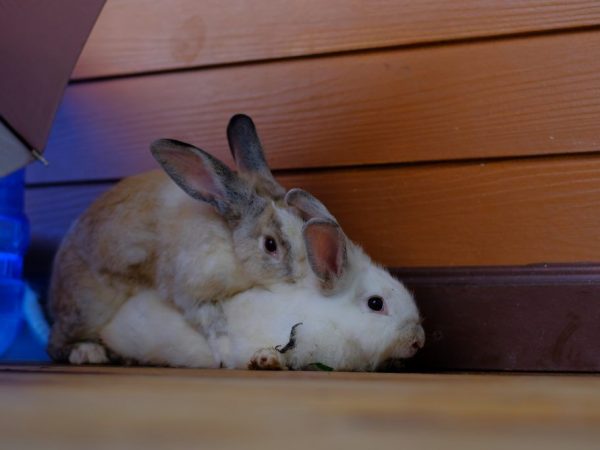
When to Bring Bunnies
It is possible to determine the beginning of the sexual hunt of a female by her behavior. Usually females behave calmly, but with the onset of sexual heat they become restless. Occasionally, a girl may refuse food. The animal begins to tear out fur in the chest area, scatters food. The loop swells and becomes scarlet. Such signs will be the same for all varieties.
For rabbits that have brought offspring more than once, the time of the onset of sexual heat after birth in the first 24-48 hours is characteristic. Sometimes the female does not have milk until the moment when the animal need is satisfied. Rabbits, under optimal conditions, are capable of breeding all year round.
Preliminary preparation
Breeding rabbits at home requires some preliminary preparation. Half a month before mating, the animals are fully checked for diseases, the necessary vaccinations are made, if necessary, they are weighed. Lean individuals are transferred to a high-calorie diet. Males, a couple of weeks before mating, are introduced into the diet of a mash of boiled potatoes with oats. Females are given highly concentrated feed.
Before mating in females, an examination of the nipples and external genital organs is carried out. The female should have 8 or 10 nipples. All animals with deviations are culled for meat. Animals that are in the stage of active molting are never brought together.
To obtain the highest results, females who have given birth several times are planted with young males, and vice versa: inexperienced females are planted with already tested males. It is important to remember that it is the female that is placed next to the male, and not vice versa, otherwise the male will feel insecure and behave a little aggressively. Feeders and drinkers are pre-removed from the rabbit house.
How to mix rabbits correctly
Rabbits should not be left alone during mating. The female may not accept the crawl, and they will start fighting. The process is considered successful when, after mating, the male falls on the side and hums softly (some do not purr). The whole action is repeated a couple of times.
After that, the female is put back in her cage. If, after a couple of hours, the behavior of the female has not changed, she is returned to the same male. When there is no result the second time, the male is changed. Control mating is carried out on the 5-6th day. If the female does not accept the male, this is a sure sign that the previous mating was successful.
Breeding rabbits in winter should be done under appropriate conditions. For this, the cells are additionally insulated. After fertilization, the female is provided with more thorough care and a number of feedings are added.
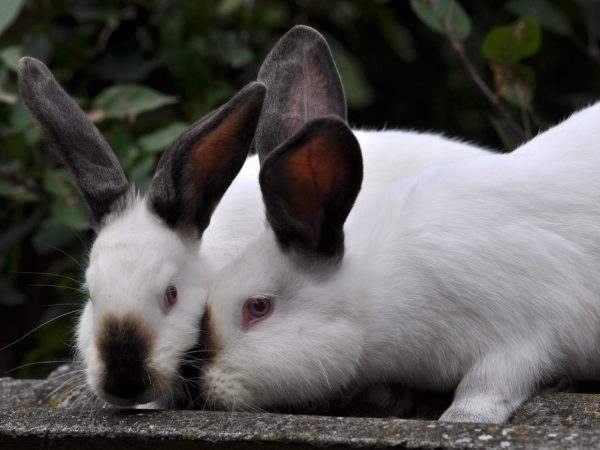
Correct mixing of rabbits
At home, rabbits reproduce not only naturally: the method of artificial insemination is practiced. This procedure is considered the most effective. The female is placed next to the male. As soon as they get down to business, the veterinarian substitutes a test tube and collects sperm, after which he injects it artificially with a special syringe to the female. Farmers, especially beginners, should make sure to keep records. The diaries note the performance of each individual, the dates of the coverings and other important information.
Inbringing
Close relationships are undesirable for any animals. Degeneration occurs and the risk of developing all kinds of genetic pathologies is very high.However, experienced breeders deliberately crossbreeds within the genus in order to breed a new breed. Inbreeding can be:
- random;
- compelled.
Accidental inbreeding is carried out only when the young have not been bred on time. Such a procedure is very harmful to the health of animals, therefore, in order to dilute the blood, it is better to purchase a breeding rabbit from another breeder. If this is not possible, distant-related individuals are brought together.
How to check if pairing was successful
Already 10 days after the information, it is possible to determine the presence of pregnancy in the female. They sit her down on a flat table and turn her head to her. The rabbit needs to be fixed with one hand, taking by the withers. Many females become aggressive during pregnancy, so special care should be taken. With the second hand, they begin to gently probe the abdomen.
In a pregnant individual, the lower abdomen will be firm. During this period, the uterus is already enlarged and filled with fluid. During palpation, the embryos themselves can be felt. They will feel like grapes to the touch. The speed of bearing depends on the breed characteristics, as well as on the experience of the female. On average, the gestation period is a month, however, in fertile individuals giving numerous litters, pregnancy lasts less.
Conclusion
The ability of female rabbits to reproduce often is one of the main features of this species, which makes breeding them at home a very profitable investment. All this is the reason why rabbit breeding is becoming more and more popular every year. For novice farmers, special training videos are shot in which they talk about the proper care and maintenance of rabbits.
Rabbits breed all year round, quickly give birth to offspring in a short time. In order for the economy to flourish, you need to follow certain rules of maintenance, and also know all the features of the mating. All this information can also be gleaned from the corresponding thematic video.


